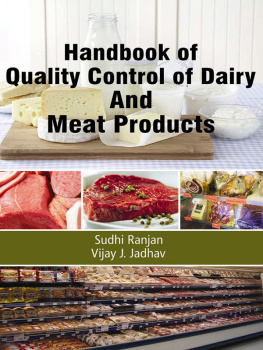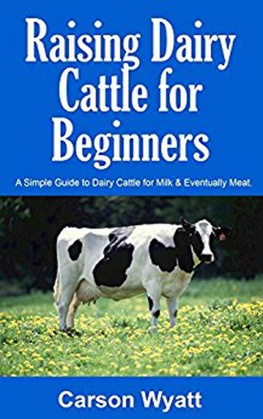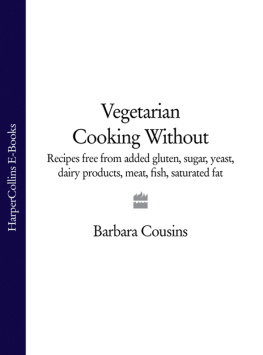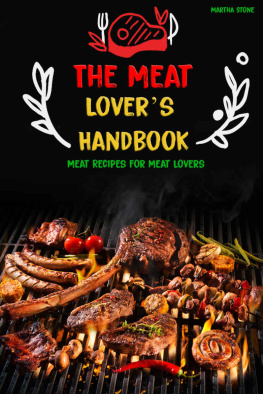Garg Sudhi Ranjan - Handbook of quality control of dairy and meat products
Here you can read online Garg Sudhi Ranjan - Handbook of quality control of dairy and meat products full text of the book (entire story) in english for free. Download pdf and epub, get meaning, cover and reviews about this ebook. City: New Delhi, year: 2012, publisher: Biotech Books, genre: Home and family. Description of the work, (preface) as well as reviews are available. Best literature library LitArk.com created for fans of good reading and offers a wide selection of genres:
Romance novel
Science fiction
Adventure
Detective
Science
History
Home and family
Prose
Art
Politics
Computer
Non-fiction
Religion
Business
Children
Humor
Choose a favorite category and find really read worthwhile books. Enjoy immersion in the world of imagination, feel the emotions of the characters or learn something new for yourself, make an fascinating discovery.
- Book:Handbook of quality control of dairy and meat products
- Author:
- Publisher:Biotech Books
- Genre:
- Year:2012
- City:New Delhi
- Rating:4 / 5
- Favourites:Add to favourites
- Your mark:
- 80
- 1
- 2
- 3
- 4
- 5
Handbook of quality control of dairy and meat products: summary, description and annotation
We offer to read an annotation, description, summary or preface (depends on what the author of the book "Handbook of quality control of dairy and meat products" wrote himself). If you haven't found the necessary information about the book — write in the comments, we will try to find it.
Handbook of quality control of dairy and meat products — read online for free the complete book (whole text) full work
Below is the text of the book, divided by pages. System saving the place of the last page read, allows you to conveniently read the book "Handbook of quality control of dairy and meat products" online for free, without having to search again every time where you left off. Put a bookmark, and you can go to the page where you finished reading at any time.
Font size:
Interval:
Bookmark:

Meat Products
Meat Products
Sudhi Ranjan Garg
Vijay J. Jadhav

2014
BIOTECH BOOKS
Reserved 2014
Sudhi Ranjan Garg
Vijay J. Jadhav
ISBN 978-81-7622-243-3
EISBN 9789351304159
Printed Format: 2012 EBOOK 2014
All rights reserved. No part of this publication may be reproduced,
stored in a retrieval system, or transmitted in any form or by any
means, electronic, mechanical, photocopying, recording or otherwise,
without the prior written permission of the authors.
Published by
BIOTECH BOOKS
4762-63/23, Ansari Road, Darya Ganj,
New Delhi-110002 (India)
Phone: 23262132
E-mail:
Laser Typesetting by : Deep Graphics, Delhi
PRINTED IN INDIA
Contents
Preface
Dairy and meat products have a substantial contribution in food security of a country. The standards of hygiene during production and highly perishable nature of the animal products influence the product safety, keeping quality, economics and acceptability, particularly in the developing countries with warm climates. Food safety is an increasingly important public health issue that has rising consumer concern all over the world. National and international agencies are constantly intensifying their efforts to improve food safety and quality everywhere. Strict food quality control measures are necessary at all stages of the food supply chain beginning with the primary production, through processing, storage, distribution and consumption to ensure that food supplies are nutritious and safe with good shelf-life.
Inspection of the food processing plants and food establishments, collection of food samples and laboratory analysis of the samples by the food regulatory agencies is indispensable to establish that necessary control measures for food quality and safety are taken by the manufacturers and distributors. It is quite essential to provide documentary evidence that the food of a particular lot is wholesome, hazard-free and fit for human consumption. This is particularly so while dealing with the export or import of foods because it may be mandatory in the international trade to follow the international standards, guidelines, and other recommendations for food quality and safety.
The major hazards in foods include: (i) Microbiological hazards such as pathogenic microorganisms, (ii) chemical hazards like toxic chemicals and adulterants, and (iii) physical hazards like dirt, hair, insects etc. Inspection of food establishments involves a detailed examination of premises, production facilities, food products, storage facilities, and the methods of handling and transport of the products to gain an insight to the food production practices and management in respect of food quality. Laboratory analysis of food samples, on the other hand, checks the quality and safety of the product and gives a detailed report. It helps in comparing the results with the prescribed specifications and, thus, in deciding the acceptability of the food product. It is utmost important that the task of inspection and laboratory analysis is accomplished by skilled persons using reliable and prescribed procedures to avoid any subsequent dispute.
This handbook is a humble attempt to elaborate the procedures and techniques of inspection and analysis of dairy and meat products in a simple but systematic manner. Regulatory guidelines concerning different kinds of hazards associated with these products have also been mentioned at appropriate places. It will not only assist the readers to make unwavering judgement about the quality of the product but will also make this handbook an indispensable reference material. Simultaneously, enough space for practice and recording the real-time observations in the handbook is certain to raise the confidence level of the users. The readers shall find the handbook really convenient and handy not only during studies but also as a refresher source throughout their career.
Sudhi Ranjan Garg
Vijay J. Jadhav
Module 1
Sanitary collection of milk samples and rapid quality evaluation tests
Wholesome and safe milk supply to the consumers necessitates its quality evaluation at different stages of production and marketing. Therefore, milk is subjected to different tests in order to find out its chemical composition and microbiological quality. Some of these tests are quite rapid while others require lengthy protocols to follow that are time consuming. Even the most careful analysis becomes useless if the collection of sample for examination is faulty and inaccurate. Improper samples cause deviation from true values of the results of the analytical parameters. This in turn leads to wrong interpretations about the quality of the product resulting in either rejection of the product of acceptable quality or may result in the acceptance of inferior product. In both the cases, there is loss to the society, either in terms of money or in terms of health hazards to the consumers. It is, therefore, quite important that samples should be collected accurately according to the established guidelines and procedures.
1.1 Sanitary collection of milk samples for chemical and microbiological examination
1.1.1 General guidelines for sample collection
A sample should be collected by an authorized, qualified, trained and experienced person. It is also necessary to ensure that the said person is free from infectious diseases.
The purpose of sample collection should be known to the person who is engaged for this task i.e. whether the sample is meant for chemical examination or for bacteriological examination. This is important as the procedures, equipment and the method of transportation depend upon the type of analysis of the sample.
Thorough mixing of milk should be carried out before collecting sample in order to ensure that the sample is true representative of the whole lot.
While mixing the milk in a container, violent mixing should be avoided since it causes churning of fat globules and generation of air bubbles which influence the results of analysis.
Extra care should be taken while collecting the sample of frozen milk because its composition does not remain uniform throughout. Usually frozen portion is rich in water whereas the liquid portion is rich in solids. Therefore, frozen milk must be warmed to a temperature of 40C in a water bath prior to collecting sample.
The milk samples meant for microbiological analysis should invariably be transported in chilled condition (in ice box or in refrigerator) whereas, the samples meant for chemical analysis can be preserved by adding 40% formaldehyde at the rate of 0.1 ml per 30 ml of milk. Other preservatives include potassium dichromate (0.5 ml of 14% solution per 250 ml milk), sodium azide (80 mg per 100 ml milk) and bronopol i.e. 2- bromo-2-nitro-1,3-propanediol (20 mg per 100 ml).
Each sample container should be sealed and labeled and should be accompanied with a report documenting the particulars of date, place, time, name and designation of sampling official and the precise method of sampling.
The report should be signed by the sampling official and the witnesses.
Samples should be taken in duplicate, one is sent to the laboratory for analysis while the other may be stored for any further use.
Next pageFont size:
Interval:
Bookmark:
Similar books «Handbook of quality control of dairy and meat products»
Look at similar books to Handbook of quality control of dairy and meat products. We have selected literature similar in name and meaning in the hope of providing readers with more options to find new, interesting, not yet read works.
Discussion, reviews of the book Handbook of quality control of dairy and meat products and just readers' own opinions. Leave your comments, write what you think about the work, its meaning or the main characters. Specify what exactly you liked and what you didn't like, and why you think so.













